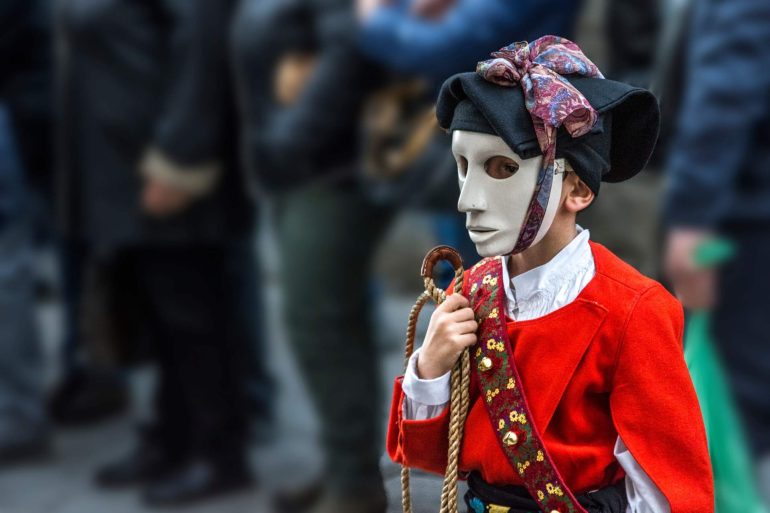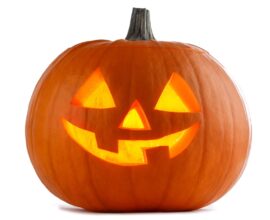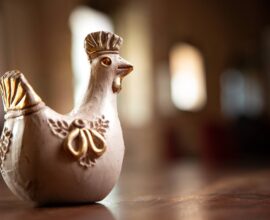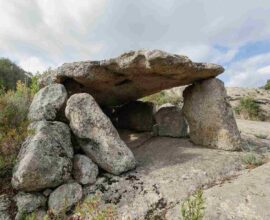Sardinian Carnival: the most beautiful masked characters and their stories
Sardinian Carnival: discovering the most fascinating masked characters and their symbolism
The many faces of the Sardinian Carnival evoke the mystery and charm of this ancient agro-pastoral culture.
Carnival in Sardinia has an identity of its own, different from the common idea of a cheerful party, full of laughter and confetti: on the island, the Carnival has many faces and transmits a unique atmosphere that evokes ancient rural and agro-pastoral customs.
The protagonists are men and animals. These masked characters cause a shiver down the spine: with a dark appearance, they symbolize man’s incessant struggle with nature and the yoking of livestock by the shepherd.
Each Sardinian village boasts its own traditions and characters cloaked in an aura of ancient mysticism and otherworldliness. Here is a rundown of the most evocative ones.
Mamuthones and Issohadores at the Mamoiada Carnival
Symbols of the village of Mamoiada are the Mamuthones and the Issohadores, born from the agro-pastoral or Dionysian rites practised in antiquity.
Their first official outing takes place on January 17th during the festival of Sant’Antonio Abate, in an unmissable ceremony along the streets of the town.
Twelve Mammuthones, one for each month, wear dark sheepskins, a wooden mask with an imperturbable expression, a woman’s handkerchief tied around the mask and hop ringing the 30-kilo bells they wear tied on their backs.
The Issohadores are eight and wear bright clothes, red jackets, white trousers, a black shawl knotted on the side, a black hat and a leather belt over the shoulder.
Thurpos at the Carnival of Orotelli
Thurpos, “the cripples”, are the typical masked characters of the Carnival of Orotelli, in the province of Nuoro. They represent everyday pastoral life, with their faces covered with soot, cowbells on their backs to ward off evil spirits and coats of orbace wool.
Some impersonate shepherds while others pose as oxen or as blacksmiths who shoe the oxen.
La Ratantira and Cancioffali at the Carnival of Cagliari
The Carnival in the Sardinian capital is characterised by a goliardic and ironic spirit, with a procession of typical characters of the ancient Cagliari: su caddemis, the beggar, sa panettera, the gossipy baker and sa fiùda, the inconsolable widow.
Su Banditori, the toastmaster opens the procession. Walking along the streets of the historic districts, he intones a famous Sardinian nursery rhyme: “Càmbara, Càmbara, Càmbara and maccioni, pisciurrè, sparedda and mummungioni! “, a hymn to the sea and its fruits.
On the day of Pentolaccia, a papier-mâché statue of Canciofalli is burnt amongst laughter and screams. Canciofalli, or King Giorgio or Giorgi, is a pagan deity who was worshipped to obtain a prosperous harvest even before Roman times.
The faceless knights of Sa Carrela e’Nanti of the Carnival of Santulussurgiu
Not far from Oristano, at the Carnival of Santu Lussurgiu, we find an ancient equestrian carousel, “Sa Carrela e’Nanti“, or “the road in front”.
Magnificent horses run along Via Roma, a 350-meter descent covered, for the occasion, with sawdust and straw and create spectacular choreographies. Their knights are selected amongst the Village’s population and all wear their faces covered with a mask or paint.
Su Componidori at the Carnival of Oristano
In Oristano, the equestrian joust called Sartiglia takes place on the last Sunday and Tuesday of the Carnival period.
The undisputed protagonist is the character of Su Componidori, chosen by the Gremi dei Falegnami e dei Contadini, on which the harvest of the year depends. The more stars he manages to skewer with his sword, the more prosperous the harvest will be.
The dressing of the chosen rider is a sacred moment for the whole community: he wears a shirt, white leather pants, mask, lace veil, coietto and top hat. Once dressed, he can no longer touch the ground but climbs on horseback from “sa mesitta” (a table) and remains there until the end of the carousel.
Sos Boes and Sos Merdules at the Ottana Carnival
A few kilometres from Nuoro, the Ottana Carnival is considered a reinterpretation of the Dionysian cult and boasts the most famous characters of Sardinia, full of mystery and charm.
The protagonists are Sos Boes, the oxen and Sos Merdules (the masters of the oxen) who chase each other in a dance that wants to exorcise the transformation of man into an animal.
Alongside them, the only female character among the Sardinian carnivals, however, personified by a man, appears. The Filonzana is the old woman feared by all, with her face covered by a wooden mask, curved and dressed in black.
Su Bundhu at Orani Carnival
A typical mask of the village of Orani (Nuoro) is Su Bundhu, which is made of cork and covers the whole face.
Its features are human but the horns are bovine, the look is enigmatic, and the hooked nose and moustache are sloping.
He carries the trident, “su thrivuthu“, and wears “su saccu“, a black cloak made of orbace wool.
Would you like to admire the most evocative characters of the Sardinian Carnival and enjoy a fabulous holiday in an authentic paradise? Discover Forte Village Resort in Sardinia






